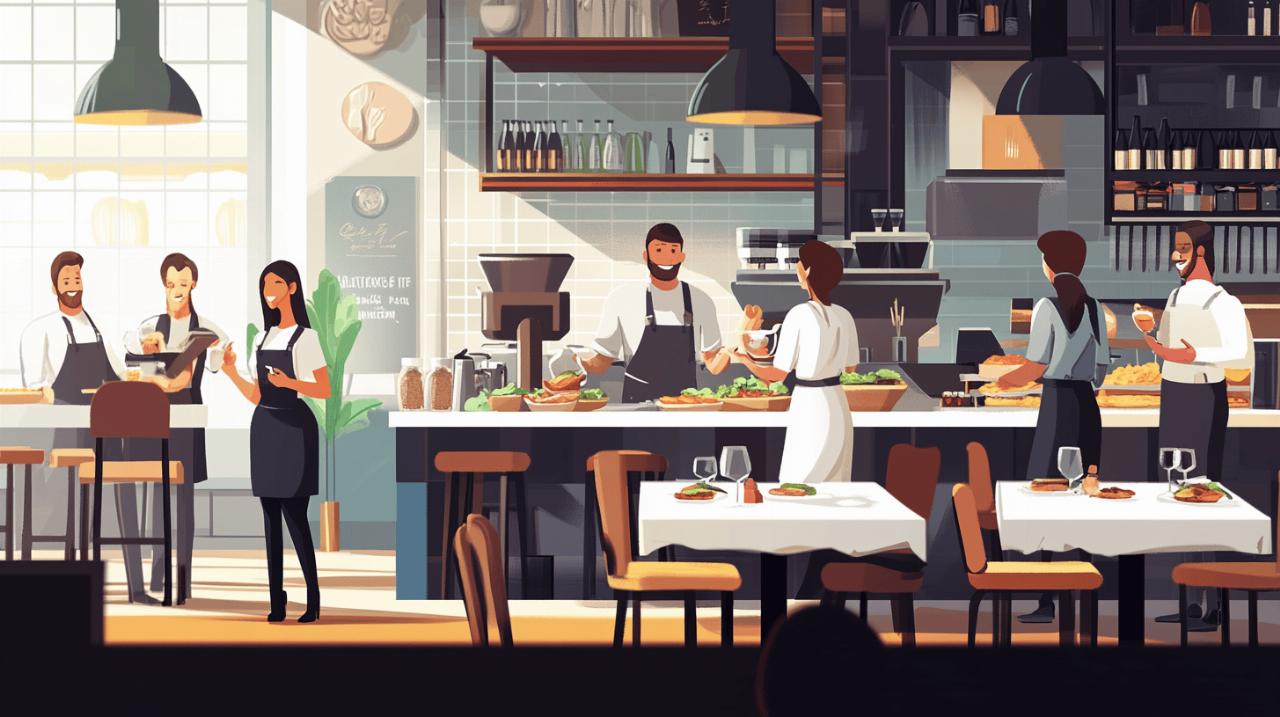How to Combat Staff Turnover in Your Restaurant: A Supportive Leadership Approach
The restaurant trade faces a persistent challenge that drains resources and disrupts operations: staff simply don't stick around. With turnover rates often soaring above seventy percent annually, owners and managers find themselves locked in a costly cycle of recruitment and training. Yet this needn't be the inevitable reality. By adopting a supportive leadership approach that genuinely values team members, restaurants can transform their workplace culture, retain talented staff, and ultimately create a more successful business. The key lies in understanding why people leave and implementing practical strategies that address these underlying concerns.
Understanding Why Staff Leave: Getting to the Root of the Problem
Before any meaningful change can occur, restaurant leaders must honestly assess why their staff are walking out the door. The reasons are rarely mysterious, though they're often overlooked in the daily rush of service. Poor compensation sits at the heart of many departures, with research indicating that more than half of restaurant workers who planned to leave permanently cited inadequate pay as their primary motivation. When staff struggle to make ends meet despite working long shifts, loyalty becomes an unaffordable luxury.
The Real Cost of High Turnover in the Restaurant Trade
The financial impact of losing staff extends far beyond the inconvenience of being short-handed during a busy evening service. Every departure triggers a cascade of expenses that quickly accumulate. When a single employee leaves, the business faces costs approaching six thousand pounds, encompassing everything from the administrative burden before they depart through to recruiting, selecting, and training their replacement. Productivity suffers during the transition period, as remaining staff shoulder extra responsibilities whilst new hires find their feet. For general managers, the financial toll becomes even more severe, with replacement costs ranging between fifteen thousand eight hundred and twenty-three thousand seven hundred pounds. These figures represent substantial sums that could otherwise be invested in improving the business, upgrading equipment, or rewarding the loyal team members who remain.
Common reasons restaurant staff walk away
Beyond compensation issues, the restaurant environment presents unique challenges that drive staff away. Unpredictable scheduling creates havoc in personal lives, making it nearly impossible for workers to maintain commitments outside their job. The stress inherent in hospitality work, particularly during peak periods, can become overwhelming without proper support structures. Management practices play a crucial role in retention, and poor leadership consistently emerges as a significant factor in staff departures. When managers fail to communicate effectively, provide guidance, or show appreciation, even the most dedicated workers lose motivation. Limited opportunities for career progression leave ambitious team members feeling trapped in roles with no future. Inadequate training programmes compound these problems, leaving staff feeling unprepared and undervalued. The cumulative effect of these factors creates an environment where leaving seems not just reasonable but necessary for personal wellbeing and professional development.
Building a Supportive Culture: Creating a Workplace People Want to Stay In
Transforming a high-turnover environment requires deliberate effort to cultivate a workplace culture that prioritises staff wellbeing and professional growth. The most successful restaurants recognise that their team members are their greatest asset, not merely replaceable cogs in an operational machine. Creating such a culture begins with genuine commitment from leadership and permeates every aspect of the business.
Proper training and professional development opportunities
Investment in comprehensive training yields remarkable returns. Evidence suggests that sixty-nine percent of employees who receive thorough training choose to remain with their employer for longer periods. Yet training must extend beyond a cursory introduction to the menu and basic procedures. Effective programmes adapt to different staff segments, recognising that short-term employees require intensive onboarding focused on essential menu knowledge and hospitality standards, whilst those planning longer tenures benefit from continuous learning opportunities and pathways toward leadership roles. Mobile training platforms have revolutionised how restaurants can deliver consistent, accessible education to their teams. When Original ChopShop implemented a purpose-built frontline training system, their training completion rate surged from a dismal thirty to forty percent to an impressive ninety-four percent. This dramatic improvement demonstrates how the right tools and commitment to staff development can transform engagement and retention. Career development opportunities signal to ambitious team members that growth is possible within the organisation, reducing the temptation to seek advancement elsewhere.
Recognition, rewards, and fair compensation packages
Competitive compensation packages form the foundation of any retention strategy. Restaurants must acknowledge that whilst hospitality work demands physical stamina, emotional intelligence, and technical skill, pay scales often fail to reflect these requirements. Offering wages and benefits that genuinely compete with other industries helps attract and retain quality staff. Beyond base pay, modern workers increasingly value financial flexibility, with seventy-nine percent stating they would switch employers for access to on-demand pay options. Providing next-day payment facilities removes financial friction that causes stress and distraction. Recognition programmes that celebrate achievements, whether through formal awards or simple acknowledgement during team meetings, reinforce that contributions are noticed and valued. Some progressive establishments have replaced traditional bonus structures with guaranteed compensation, providing financial stability that allows staff to plan their lives with confidence. Retention bonuses that reward longevity can prove particularly effective, with structured payments at significant milestones demonstrating tangible appreciation for loyalty.
Effective leadership and management practises
 The quality of management directly influences whether staff choose to stay or seek opportunities elsewhere. Even generous pay and excellent training programmes cannot compensate for poor leadership. Restaurant owners must therefore prioritise developing their management team's capabilities, ensuring they possess not just operational expertise but the interpersonal skills necessary to inspire and support their staff.
The quality of management directly influences whether staff choose to stay or seek opportunities elsewhere. Even generous pay and excellent training programmes cannot compensate for poor leadership. Restaurant owners must therefore prioritise developing their management team's capabilities, ensuring they possess not just operational expertise but the interpersonal skills necessary to inspire and support their staff.
Training managers to be supportive leaders who communicate well
Managers set the tone for the entire workplace culture. When they lead with empathy, communicate clearly, and demonstrate genuine concern for their team's wellbeing, staff respond with increased engagement and loyalty. Leadership development programmes should emphasise active listening skills, constructive feedback techniques, and conflict resolution strategies. Regular communication between managers and their teams prevents minor concerns from festering into resignation-worthy grievances. Biannual performance reviews provide structured opportunities for meaningful conversations about career progression, challenges, and aspirations. Technology can support better management practises by reducing administrative burdens. Systems that streamline scheduling tasks allow managers to reclaim time spent on logistics and redirect it toward coaching and supporting their teams. Maintaining appropriate spans of control ensures managers can remain hands-on and responsive. Regional oversight structures that limit each manager to supervising four to six locations enable more meaningful relationships and faster response to emerging issues than trying to manage a dozen or more sites from a distance.
Flexible rotas and promoting work-life balance
The demanding nature of restaurant work makes flexibility and work-life balance not merely desirable perks but essential retention factors. Unpredictable scheduling wreaks havoc on personal relationships, childcare arrangements, and physical health. Forward-thinking establishments implement scheduling practices that provide staff with advance notice and input into their rotas. Acknowledging that people have lives outside work and accommodating their needs where possible demonstrates respect and builds goodwill. Employee wellness programmes that address mental health resources, adequate rest periods, and strategies for managing the inevitable stress of service work show genuine concern for long-term staff wellbeing rather than viewing them as expendable resources to be exploited during busy periods and discarded when convenient.
The business case for retaining your team
Whilst ethical considerations alone justify treating staff well, restaurant owners operating in competitive markets need to understand the business advantages of reducing turnover. The evidence overwhelmingly demonstrates that retention strategies generate measurable returns that directly impact profitability and operational success.
Cost savings and improved productivity through staff retention
Reducing employee turnover delivers immediate financial benefits. The thousands of pounds spent replacing each departing team member flow directly back into the business when staff choose to remain. Organisations employing professional employer organisation services often achieve turnover reductions between ten and fourteen percent, translating to substantial annual savings. Beyond direct cost savings, experienced staff work more efficiently, make fewer errors, and require less supervision. As tenure increases, productivity naturally improves whilst training costs decrease. The system-based approach pioneered by establishments like Original ChopShop demonstrates these principles in action, achieving turnover rates nearly half the industry average through thoughtful workforce segmentation and targeted retention strategies. When staff stay longer, institutional knowledge accumulates rather than constantly draining away, creating operational stability that allows the business to function more smoothly even during challenging periods.
How happy staff lead to better customer experiences
The connection between staff satisfaction and customer experience forms perhaps the most compelling business case for reducing turnover. Happy, well-trained team members who feel valued and supported naturally provide superior service. They develop relationships with regular customers, anticipate needs with practiced ease, and navigate challenging situations with confidence born from experience and organisational support. Constant staff turnover creates a disjointed customer experience marked by inconsistency and errors as new hires struggle to master their roles. Conversely, stable teams develop cohesion and efficiency that guests notice and appreciate. When staff genuinely enjoy their workplace and believe in the organisation, their enthusiasm becomes contagious, creating an atmosphere that draws customers back repeatedly. The virtuous cycle of happy staff creating satisfied customers who return more frequently and spend more generously ultimately drives the revenue growth and profitability that every restaurant seeks. Viewing retention as a strategic business priority rather than merely a human resources concern shifts the entire organisational approach, recognising that the people serving food and welcoming guests are the most valuable investment an establishment can make.
